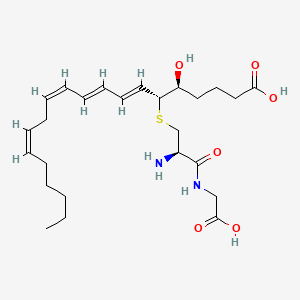| Sylvin H et al. |
Cysteinyl leukotrienes in porcine acute allergic airway reactions: bronchial and vascular effects. |
2003 |
Inflamm. Res. |
pmid:12813622
|
| Vargaftig BB and Singer M |
Leukotrienes mediate murine bronchopulmonary hyperreactivity, inflammation, and part of mucosal metaplasia and tissue injury induced by recombinant murine interleukin-13. |
2003 |
Am. J. Respir. Cell Mol. Biol. |
pmid:12654629
|
| Chibana K et al. |
Up-regulation of cysteinyl leukotriene 1 receptor by IL-13 enables human lung fibroblasts to respond to leukotriene C4 and produce eotaxin. |
2003 |
J. Immunol. |
pmid:12682264
|
| Liu P et al. |
Cysteinyl leukotriene-dependent [Ca2+]i responses to angiotensin II in cardiomyocytes. |
2003 |
Am. J. Physiol. Heart Circ. Physiol. |
pmid:12531730
|
| Hattori T et al. |
Effects of H2O2 on membrane potential of smooth muscle cells in rabbit mesenteric resistance artery. |
2003 |
Eur. J. Pharmacol. |
pmid:12620501
|
| Mizutani N |
[Studies on the experimental allergic rhinitis induced by Japanese cedar pollen--role of cysteinyl leukotrienes in nasal allergic symptoms]. |
2003 |
Yakugaku Zasshi |
pmid:12607939
|
| Bouchelouche K et al. |
The cysteinyl-leukotriene D4 induces cytosolic Ca2+ elevation and contraction of the human detrusor muscle. |
2003 |
J. Urol. |
pmid:12853847
|
| Nagase T et al. |
A potent inhibitor of cytosolic phospholipase A2, arachidonyl trifluoromethyl ketone, attenuates LPS-induced lung injury in mice. |
2003 |
Am. J. Physiol. Lung Cell Mol. Physiol. |
pmid:12505870
|
| Kurogi Y |
Mesangial cell proliferation inhibitors for the treatment of proliferative glomerular disease. |
2003 |
Med Res Rev |
pmid:12424751
|
| Marusova IB et al. |
[Potential gastroprotective effect of a CysLT1 receptor blocker sodium montelukast in aspirin-induced lesions of the rat stomach mucosa]. |
2002 May-Jun |
Eksp Klin Farmakol |
pmid:12227087
|
| Thodeti CK and Sjölander A |
Leukotriene D4-induced calcium signaling in human intestinal epithelial cells. |
2002 |
Adv. Exp. Med. Biol. |
pmid:12664584
|
| Ohshima N et al. |
A functional study on CysLT(1) receptors in human eosinophils. |
2002 |
Int. Arch. Allergy Immunol. |
pmid:12373000
|
| Maekawa A et al. |
Targeted gene disruption reveals the role of cysteinyl leukotriene 1 receptor in the enhanced vascular permeability of mice undergoing acute inflammatory responses. |
2002 |
J. Biol. Chem. |
pmid:11932261
|
| Tada N et al. |
Experimental otitis media with effusion induced by leukotriene D4. |
2002 |
Auris Nasus Larynx |
pmid:11893446
|
| Li X and Weinman SA |
Mrp2 modulates the activity of chloride channels in isolated hepatocytes. |
2002 |
Hepatology |
pmid:12085350
|
| Li PC et al. |
Enhanced activity of Ca2+-activated K+ channels by 1-[2-hydroxy-3-propyl-4-[(1H-tetrazol-5-yl)butoxyl]phenyl] ethanone (LY-171883) in neuroendocrine and neuroblastoma cell lines. |
2002 |
J. Cell. Physiol. |
pmid:12115725
|
| Massoumi R et al. |
Leukotriene D(4) induces stress-fibre formation in intestinal epithelial cells via activation of RhoA and PKCdelta. |
2002 |
J. Cell. Sci. |
pmid:12154081
|
| Han B et al. |
Gamma-glutamyl leukotrienase, a novel endothelial membrane protein, is specifically responsible for leukotriene D(4) formation in vivo. |
2002 |
Am. J. Pathol. |
pmid:12163373
|
| Paruchuri S et al. |
Leukotriene D(4) activates MAPK through a Ras-independent but PKCepsilon-dependent pathway in intestinal epithelial cells. |
2002 |
J. Cell. Sci. |
pmid:11956320
|
| Stelmach I et al. |
[The effect of inhaled heparin on post-leukotriene bronchoconstriction in children with bronchial asthma]. |
2002 |
Pol. Merkur. Lekarski |
pmid:11995261
|
